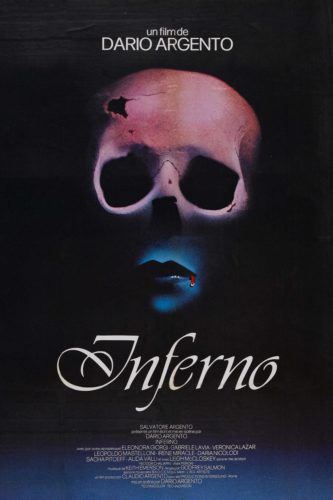 This, the second entry in Dario Argento’s Three Mothers trilogy, is the most overtly nightmarish film Argento has ever made. For that matter, it’s one of the most authentically dreamlike films of all time, a gorgeous and darkly seductive celluloid hallucination.
This, the second entry in Dario Argento’s Three Mothers trilogy, is the most overtly nightmarish film Argento has ever made. For that matter, it’s one of the most authentically dreamlike films of all time, a gorgeous and darkly seductive celluloid hallucination.
The 1980 INFERNO followed Dario Argento’s 1977 SUSPIRIA, and preceded 2007’s MOTHER OF TEARS. It is in my view the most memorable of the three films, even though it wasn’t much of a success. It didn’t even get a theatrical release in the U.S., which is a shame, as, like SUSPIRIA before it, it really needs to be experienced on a big screen—and preferably one with a top flight sound system!
In a forbidding New York City apartment building a young woman named Rose reads a book about the “Three Mothers” who govern reality, and three corresponding keys hidden in various arcane locations. Searching for one of those keys, Rose enters the basement of the building and drops her necklace into what looks like a puddle. That puddle is actually a vast water-filled underground room into which Rose immerses herself to find her necklace—and disgorges a rotting corpse in the process!
Cut to Rose’s sister-in-law in Rome, who reads a missive sent by Rose and is inspired to search out the Three Mothers book. She finds the volume but stumbles into a strange room where a scary dude holds court—wanting her book, the weird guy attacks her. She runs off. Back in her apartment building she meets a guy in an elevator who follows her to her room (as he’s “got nothing to do for the next couple of hours”). He ends up stabbed in the neck by an unseen attacker and she in the back.
From there we cut back to Rose in New York, who after calling her brother Mark is chased into a rundown section of her building. There she’s beheaded with a pane of glass.
Mark arrives in New York but can’t find his sister. He falls in with a lady friend of Rose’s who lives in the same building. But the two are quickly separated and Rose’ friend is attacked by several cats and then stabbed to death by another of those unseen attackers.
More murders occur: a bookstore owner residing in the building is chewed up by rats and gored in the neck after drowning a bag-full of yowling cats, and the concierge and his wife, who are involved in a plot of some sort to get rid of their tenants, are both killed, he via bludgeoning and she by burning.
Around this time Mark pries up floorboards and discovers a floor between floors, which leads him to a hidden room where he confronts the “Mother of Shadows,” a.k.a. Death.
This is among the most colorful of Argento’s films, bathed in incredibly stark, garish shades of red and blue. The wildly baroque scenery is a riot of ornate statues and architecture that’s quintessentially Italian (even in the New York sequences).
The editing is jittery and discordant, alternating extreme close-ups and wide shots with little thought for slickness or craftsmanship. The cutting matches the narrative, which is disconnected and incoherent, switching locales, plot strands and even protagonists seemingly at will. The surreal aura extends to a close up of ants crawling on a man’s open palm (a direct tribute to Salvador Dali) and the early descent into the underwater room, a sequence as blindingly hallucinatory as any you’ll see (and designed, reportedly, by the late Mario Bava).
Then there’s the score by Keith Emerson, replacing Goblin’s music for SUSPIRIA. Emerson’s relentlessly noisy, insistent score, which often sounds like a rock ’n roll variant on “Carmina Burana,” is very Goblin-esque, and (as in SUSPIRIA) was mixed at an incredibly LOUD volume. Argento’s reasons for doing so remain vague, but the ear-splitting music is a key component of INFERNO (and one that’s completely lost on DVD).
INFERNO sometimes feels like a dreamlike stalk ‘n slash movie packed with the type of creative killings that characterized Argento’s early giallo thrillers. Yet the atmosphere all-but drips with magic and the supernatural, rendering INFERNO one of the screen’s great dream movies.
Vital Statistics
INFERNO
Produzioni Intersound
Director: Dario Argento
Producer: Claudio Argento
Screenplay: Dario Argento
Cinematography: Romano Albani
Editing: Franco Fraticelli
Cast: Leigh McCloskey, Irene Miracle, Eleonora Giorgi, Daria Nicolodi, Sacha Pitoeff, Alida Valli, Veronica Lazar, Gabriele Lavia, Feodor Chaliapin, Leopoldo Mastelloni, Ania Pieroni
